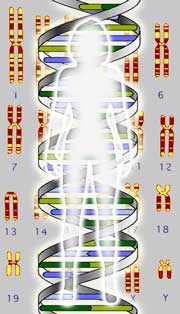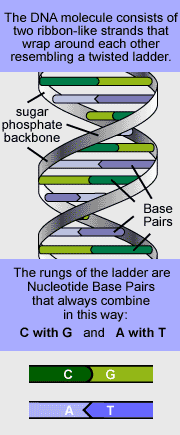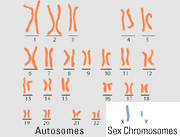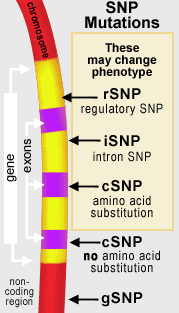|
|
 |
|
Genetics / Biotech |
 |
 |
 |
|
|
|
|
 |
|
|
|
Genetics: the study of biological heredity and variance.
In simpler terms, it's the study of how genes are passed
from parent to offspring, and how those genes create
certain characteristics in an organism. Genetics is a
term that is relevant to all biotechnology; it is a
biological area that studies how genes are inherited,
and what they do. Genetics forms the base for all
biotechnology, and in-fact, life itself. All life on the
planet is made up of DNA and genes; DNA provides the
genetic make-up for a being.
|
|
|
|
The modern age of genetics began in the early 1800s when
Jean Baptiste Lamarck (1744-1829) suggested that animals
passed on acquired traits. This means that Lamarck
believed that a baby giraffe's neck was long because its
parents stretched their necks as they tried to graze on
the leaves of tall trees. However, we now know his
hypothesis was false. For example, if a man loses his
right leg in a car accident, we don't expect his child
to be born missing a right leg. Modern biology has since
grown by leaps and bounds as scientists strive to
understand genetics and DNA by studying bacteria,
viruses, mice, plants, and thousands of other organisms.
In 1988, a committee of representatives from the
National Institutes of Health and the Department of
Energy began to develop a five year plan to construct a
physical map of the human genome. In 1990 the Human
Genome Project was born and has since grown to include
France, Britain, Japan and other countries. It is now
widely coordinated by the Human Genome Organization
(HUGO). HUGO is a private organization exclusively
devoted to coordinating worldwide genome mapping and
sequencing and to fostering collaboration between
researchers.
|
|
|
|
Introduction to Genetics |
|
|
 Basics
of Genetics Basics
of Genetics
Pharmaceuticals companie's genetic research efforts will
help change the way medicines are discovered, developed,
and prescribed and the way many diseases are diagnosed
and treated.
GSK is an industry leader in the field of genetics,
focusing on the examination of the genetic basis of
common diseases and patients' responses to medicines —
learning about the identity and function of genes
associated with diseases and understanding why some
medicines work better for certain people than others and
who is most likely to experience a serious side effect.
|
|
|
|
DNA
How do cells know what to do in your body?
How can DNA determine what you will look like? |
|
|
|
Instructions that provide almost all of
the information necessary for a living organism to grow
and function are in the nucleus of every cell. These instructions tell the cell
what role it will play in your body. The instructions
are in the form of a molecule called deoxyribonucleic
acid, or DNA.
nucleus of every cell. These instructions tell the cell
what role it will play in your body. The instructions
are in the form of a molecule called deoxyribonucleic
acid, or DNA.
DNA is the chemical responsible for
preserving, copying and transmitting information within
cells and from generation to generation.
In humans, the DNA molecule consists of
two ribbon-like strands that wrap around each other,
resembling a twisted ladder. This is often described as
a double helix. DNA is contained in tightly coiled
packets called chromosomes, found in the nucleus of
every cell. Chromosomes consist of the double helix of
DNA wrapped around proteins.
The twisted ladder is made up of
repeating units called nucleotides, each of which is a
single building block of DNA. Nucleotides are composed
of one sugar-phosphate molecule (the linear strands or
outer rails of the ladder) and one base. DNA consists of
two nucleotide strands joined by weak chemical bonds
between the two bases, forming base pairs. A base pair
is a rung or step on the ladder of the DNA. The bases
are called A (for adenine), C (for cytosine), T (for
thymine) and G for guanine.
These bases always pair up in the
following way:
· A+T
· C+G
A single strand of
DNA is made of letters:
ATGCTCGAATAAATGTGAATTTGA
The letters make
words:
ATG CTC GAA TAA ATG TGA ATT TGA
The words make
sentences:
<ATG CTC GAA TAA> <ATG TGA ATT TGA>
These "sentences" are called genes.
Genes tell the cell to make other molecules called
proteins. Proteins are required for the structure,
function, and regulation of the body's cells, tissues,
and organs. |
|
|
 We
have approximately three billion base pairs (6 billion
bases total) of DNA in most of our cells. This complete
set of genes is called a genome. With the exception of
identical twins, the sequence of the bases is different
for everyone, which makes each of us unique. We
have approximately three billion base pairs (6 billion
bases total) of DNA in most of our cells. This complete
set of genes is called a genome. With the exception of
identical twins, the sequence of the bases is different
for everyone, which makes each of us unique. |
|
|
DNA and Human Diversity
Although we all look quite different from one another,
we are surprisingly alike at the DNA level. The DNA of
most people is 99.9 percent the same.
Only about 3 million base pairs are responsible for the
differences among us — which is only one tenth of 1% of
our DNA. Yet these DNA base sequence variations
influence most of our physical differences and many of
our other characteristics, as well.
Sequence variations occur in our genes, and the
resulting different forms of the same gene are called
alleles. People can have two identical or two different
alleles for a particular gene.
|
|
|
Mutations
A mutation or polymorphism is a change in the DNA
"letters" of a gene or an alteration in the chromosomes.
Polymorphisms are common differences in the sequence of
DNA, occurring in at least 1% of the population.
Mutations are less common differences, occurring in less
than 1% of the population.
What is a mutation in one place may be a polymorphism in another. For example, the base change that causes sickle
cell anemia is defined as a mutation in Caucasian
populations because it occurs in less than 1% of people.
In parts of Africa where it is found in 25% of the
population, it is defined as a polymorphism.
another. For example, the base change that causes sickle
cell anemia is defined as a mutation in Caucasian
populations because it occurs in less than 1% of people.
In parts of Africa where it is found in 25% of the
population, it is defined as a polymorphism.
Most DNA variation is neutral (not beneficial or
harmful), but harmful sequence changes sometimes do
occur. Changes within genes can result in proteins that
don't work normally or don't work at all. Some of these
changes can contribute to disease or affect how someone
responds to a medicine.
Mutations may be passed down from parent to child (in
the sperm or egg cells), may occur around the time of
conception or may be acquired during a person's
lifetime.
Mutations can arise spontaneously during normal cell
functions, such as when a cell divides, or in response
to environmental factors such as toxins, radiation,
hormones, and even diet.
Nature provides us with a system of finely tuned repair
enzymes that find and fix most DNA errors. But as our
bodies change in response to age, illness and other
factors, our repair systems may become less efficient.
Uncorrected mutations can accumulate, resulting in
diseases such as cancer.
|
|
|
Genes
Genes are the basic units of heredity in living cells.
They consist of a length of DNA that contains
instructions ("codes") for making a specific protein.
Through these proteins, our genes influence almost
everything about us, including how tall we will be, how
we process foods, and how we respond to infections and
medicines.
Although most of our cells have the same genes, not all
genes are active in every cell. Heart cells synthesize
proteins required for that organ's structure and
function; liver cells make liver proteins, and so on. In
other words, not all the genes are "switched on" and
expressed as proteins within every cell. Within an
individual cell, the same genes may be switched on at
some times and switched off at other times.
|
|
|
|
|
|
|
|
Disclaimer - The
contents of this site are for informational purposes
only. Always seek the advice of a qualified
physician for any doubts. |
|
| |


